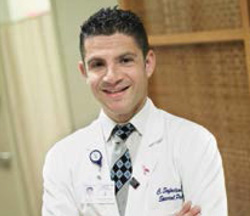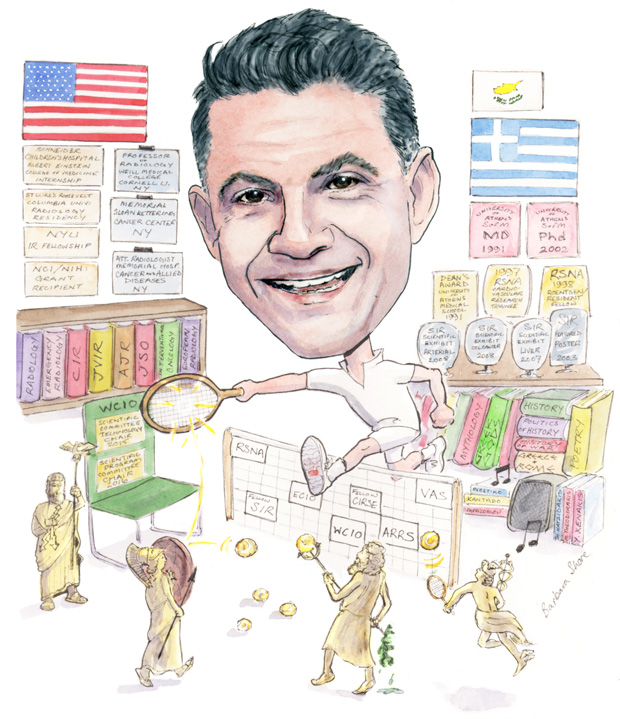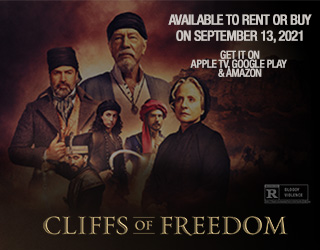Profile: Constantinos T Sofocleous

Constantinos T Sofocleous
“As interventional radiology is established as a free standing specialty, an international outreach effort to establish guidelines for different interventional treatments is certainly needed,” Constantinos T Sofocleous, Memorial Sloan Kettering Cancer Center, New York, USA, and professor of Radiology, Weill Medical College of Cornell University, New York, tells Interventional News. Sofocleous is chair of the Scientific Programme Committee of World Conference on Interventional Oncology (WCIO) 2016.
When did you first decide you wanted a career in interventional radiology?
Growing up in Cyprus and Greece, entering medical school was considered one of the highest achievements for students. It required passing a national examination in the top 5% in order to enter one of the few six-year combined college/medical school programmes run by the Ministry of Education. Medicine was on top of my list, and I was fortunate enough to enter the the University of Athens medical school in Greece with high exam scores securing me a scholarship for six years. During my early clinical rotations in paediatrics, I immediately realised the value of angiography when surgeons were asking about the arterial supply in a neuroblastoma they were planning to resect. At the time (some 25 years ago), there was no paediatric interventional physician who could undertake this task. This was the first time I was exposed to angiography and interventional radiology. From that moment onwards, I started looking into interventional radiology procedures performed in the USA and in other countries in Europe.
Who were your mentors and what wisdom did they impart to you?
I can still remember my elementary school teachers in Cyprus and Greece who taught me the value of independent and analytical thinking. I also remember a few of my medical school professors who taught me the value of studying really hard and looking into the source references to gain knowledge that stays with you. Coming to the USA in the early 90s, I was so impressed with the level of organisation and systematic approach to learning during internship and residency. Maybe one of the most important teachers in my life is Dr Jeanne Baer, the programme director at St Luke’s Roosevelt, who used to tell us to step back and look at the entire picture, including the edges of the film. Look at the name and the age of the patient— information that is available for free—that can often help make the diagnosis. Dr Baer was probably the most dedicated teacher I met during my medical training.
What is the research you have carried out that you are most proud of?
The validation that tissue examinations from the ablation zone can be strong predictors of oncologic outcomes is probably my most noteworthy research. This project started from the simple observation that charred tissue was present on the older multitined ablation devices. Colleagues and supervisors would make fun of me when I started collecting this “garbage” and sending it to pathology in the early 2000s. By 2009, I had preliminary data showing how biomarkers found in this tissue could predict early local recurrence after radiofrequency ablation of liver tumours. This led to a National Institutes of Health grant that allowed me to prospectively validate this observation with biopsies of the ablation zone immediately after treatment with ablation. The results of the first cohort of this grant were published in Radiology last month. As reported in Radiology, the study set out to establish the prognostic value of biopsy of the central and marginal ablation zones for time to local tumour progression after radiofrequency ablation of colorectal cancer liver metastases. We showed that biopsy proof of complete tumour ablation and minimal ablation margins of at least 5mm are independent predictors of local tumour progression and yield the best oncologic outcomes. I am actually very excited about this development as it is one of the first projects bringing tissue examinations, or biopsies that we usually carry out for other disciplines into our own interventional oncology practice. The impact of the tissue examinations is so strong that it can change patient management. This is an issue that I will definitely be talking about during WCIO 2016 (9–12 June, Boston, USA).
What role do you see for immunotherapy in interventional radiology treatments?
There is preliminary evidence that locoregional therapies may instigate an immune response that can act like a vaccine to cancer. This, of course, needs a lot of work in order to be tested in large scale trials in patients. One of our selected best publications of the year and a dedicated session on global effects of interventional oncology will address this issue in depth during the WCIO meeting. I am optimistic that in the near future, we might see a break-through in this innovative and very promising approach to cancer, and in particular in advanced stages of the disease.
What are the biggest challenges for interventional radiology and interventional oncology in 2016?
I think that interventional radiology is in a much better position in 2016, than say, in 2006, for example. The recognition of interventional radiology as a specialty from the National Board of Medical Specialties is the most significant change in the history of this field. I think the main challenge for now is to establish interventional radiology as a free standing specialty that provides the highest quality of services. An international outreach effort to establish guidelines for different interventional treatments is certainly needed. I do hope that the Society of Interventional Radiology (SIR) and the Cardiovascular and Interventional Radiological Society of Europe (CIRSE )will lead such initiatives. In addition, as interventional radiology becomes a free standing specialty, it will need to grow similarly to other disciplines and make room for subspecialties including interventional oncology, vascular, emergency interventional radiology. The recognition that interventional radiology is a specialty and that we are specialists who can treat certain diseases is a challenge in itself. As interventional radiologists we need to delve deep to address certain diseases, rather than use the “tools of the trade” as needed. Interventional oncology needs to strengthen its role as the fourth pillar of oncology along with medical, surgical and radiation oncology. This sounds like a cliché but truly, this is the time to build on the foundation that has been created in the last few years. We need to increase our efforts and organise good trials, registries and standards of care in interventional oncology. We have to continue to inform our medical colleagues about what interventional oncology has to offer and how this fits into the management of specific cancers. Most importantly, interventional oncology needs to offer a full clinical service for our cancer patients.

What are the most important trial results that you are awaiting in 2016?
We recently saw the results of one of the first large scale randomised, controlled phase III trials (SIRFLOX trial) that addressed the value of locoregional interventional therapy, specifically resin selective internal radiation therapy (using Sir-spheres, Sirtex) as an adjuvant to standard-of -care chemotherapy for patients with metastatic colon cancer in the liver.
These are the type of efforts that we and the industry in the field need to undertake in order to prove the value of our treatments to society. This trial proved that disease control in the liver was much better with the “combined” therapy than in the “chemotherapyonly standard of care” arm. Nevertheless, the study did not show a prolongation of progression free survival and, most importantly, overall survival in the combined arm. It is anticipated that the population of this study and the population of two other similar studies (FOXFIRE and FOXFIRE Global), will be combined to see if the addition of selective internal radiation therapy to chemotherapy prolongs patients’ survival. Such a finding would dramatically change the way we treat colon cancer patients with liver metastases. Being an interventional oncologist who has focused his practice and research on this disease, I consider these trials the most important for 2016–2017.
From your daily practice, what are three clinical questions that you would like to see answered?
– Can we perform selective internal radiation therapy in a single day without having to wait for mapping and then order the needed radioactive dose?
– Can we develop software to demonstrate the tumour and the overlapping ablation zone, calculating margins with a simple, fast technique to help during tumour ablation?
– Can we apply the personalised or precision medicine approach to interventional oncology?
Please describe a memorable case that you treated.
One case that happened very early in my career remains with me. It is the case of an 18-year-old pregnant woman who had a massive pulmonary embolus and was critically ill and intubated in the intensive care unit. We had been asked to do thrombectomy and remove the saddle pulmonary embolus, however despite the successful removal of many large thrombi, she remained critically ill. We had a very little experience with tissue plasminogen activator thrombolysis at the time (1999) but we starting discussing this as an option to improve perfusion to her pulmonary arterial bed that contained a lot of microthrombi. We did not know what the effect to the foetus would be, since she was only in the first trimester. After a lot of discussion, we performed thrombolysis overnight that allowed her to be extubated within the next few days. She quickly recovered and was discharged from the hospital within a few days. Unfortunately the pregnancy was spontaneously interrupted but the mother’s life was saved.
Now that interventional radiology is a primary specialty in the USA, what lies ahead?
The fact is that as of 2020 all interventional radiology physicians must be graduates of an Accreditation Council for Graduate Medical Education (ACGME) accredited interventional radiology residency programme. With the recognition of interventional radiology as a primary specialty in the USA, the interventional radiology community is more prepared than ever to maintain and increase its role as a significant medical discipline. This is a great recognition of the value of the specialty in the hospital setting. In the USA, it is clear that hospital care relies heavily on us. From the implantation of vascular access and the diagnosis made by biopsy to the treatment of post-surgical complications or prevention of those by interventional radiology procedures, the specialty is indispensable. The key question is how interventional radiology will evolve into a full-fledged clinical specialty with focused dedicated subspecialties that will cover the entire spectrum of pathology from vascular diseases to oncology and from emergency interventional radiology to cosmetic interventions.
Exclusively practicing interventional oncology since 2002, I have witnessed a significant change, a metamorphosis of my practice after the establishment of a continuous fully staffed and equipped clinic where all interventional patients are assessed prior to any procedure and followed after the procedure in order to provide comprehensive care. The direct interaction with the patient before and after their intervention is extremely important for patients and interventional physicians. This development and the dedicated participation in disease management teams are probably the key element that will lead to the metamorphosis of interventional radiology from a subspecialty of radiology into a full service specialty. The completion of this transformation will not be achieved without the initiation, completion and integration of relevant research, led by the interventional radiologist to a new level of depth, in order to apply and fuse developments of other disciplines with those in image-guided technology.
What are your expectations as WCIO 2016 programme chair?
The staff and the scientific committee have worked very hard to create the best possible programme for WCIO 2016. We have a fantastic line-up in terms of interventional oncology faculty joining forces with pioneers from all specialties in oncology to create 121 state of the art lectures during 21 plenary sessions. We have planned daily disease-specific tumour boards designed to bring out the most critical questions and ignite discussions amongst the audience and the experts that will keep interest high throughout the congress. There are also dedicated sessions to highlight the most influential publications of the year and evidence-based debates.
What are your interests outside of medicine?
I am a tennis addict and need to hit the courts weekly at least for three hours. This is a hobby that I have maintained since I was 12 years old. I also enjoy history and how it is reflected in politics, international conflicts and relations. I am passionate about mythology and love poetry and music, in particular ethnic music. I am always moved by good quality Greek music and lyrics. But my main focus outside medicine is my family. Dr. Gretchen Thomas Sofocleous is my loving and supportive partner. I often seek her advice and am amazed by her wisdom and patience. They must be due to her second X chromosome! Our two children, aged six and four, keep us both constantly busy.
Fact File
Current positions
2013–present
Professor of Radiology, Weill Medical College of Cornell University, New York, USA
Member, MH Memorial Sloan Kettering Cancer Center, New York, USA
Attending radiologist, Memorial Hospital for Cancer and Allied Diseases New York, USA
Educational background
1985–91 MD, University of Athens School of Medicine Athens, Greece
1997–2001 PhD, University of Athens School of Medicine Athens, Greece
Postgraduate training
1992–93 Residency, Radiology, St Sofia Children’s Hospital, University of Athens School of Medicine, Athens, Greece
1993–94 Residency, Paediatrics, Schneider Children’s Hospital, Long Island Jewish Medical Center Albert Einstein College of Medicine, New Hyde Park, USA
1994–98 St Luke’s Roosevelt Hospital Center, Columbia College of Physicians & Surgeons, New York, USA
1998–99 Fellowship, Vascular & Interventional Radiology, New York University Medical Center New York, USA
Honours and awards (selected)
1983 Greek government scholarship to study Medicine at the University of Athens
1991 Dean’s Award, University of Athens Medical School, for graduating in top 5% of class
1997 RSNA Cardiovascular Research Trainee Prize
1998 Roentgen Resident/Fellow Research Award. RSNA Research and Education Fund
Society positions and memberships (selected)
2006 Fellow, Society of Interventional Radiology (SIR)
2013 Fellow, Cardiovascular and Interventional Society of Europe (CIRSE)
2015 Chair, Scientific Committee Technology, World Conference on Interventional Oncology (WCIO)
2016 Chair, Scientific Programme Committee, WCIO
Copyright 2016 Interventional News (interventionalnews.com). Reprinted with permission.











0 comments